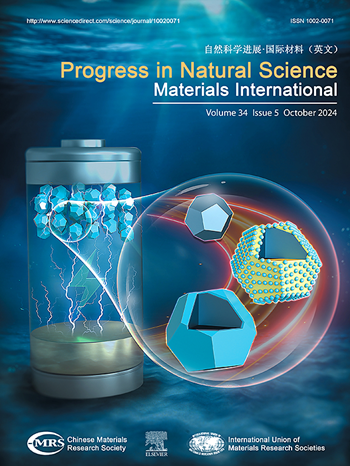Accurate reconstruction and prediction of T55511 titanium alloy microstructure using DDPM model and quantitative evaluation
IF 7.1
2区 材料科学
Q2 MATERIALS SCIENCE, MULTIDISCIPLINARY
Progress in Natural Science: Materials International
Pub Date : 2025-08-01
DOI:10.1016/j.pnsc.2025.04.002
引用次数: 0
Abstract
The exploration of the relationship between microstructure and properties is essential in materials research. However, traditional methods are often costly and time-consuming, and manual quantitative analysis is subject to high levels of subjectivity, which hinders accurate reflection of microstructural features. In this study, based on a multimodal database of the Solution-Treatment-Aging (STA) process for titanium alloys, we developed a deep learning model for microstructure-property relationships in T55511 alloy by employing a Denoising Diffusion Probabilistic Model (DDPM) with a conditional U-Net as the denoising network. The model generates high-fidelity microstructure images through progressive denoising and adaptively predicts the complex relationships between microstructure and properties based on processing conditions. Results demonstrate that the model produces images with high clarity and strong resemblance to real microstructures. Quantitative information obtained via semantic segmentation shows that the model achieves a mean absolute error (MAE) of ≤30 nm for primary phase (αp) and ≤20 nm for secondary phase (αs), closely matching real-world data. This study validates the reliability of the DDPM model in generating alloy microstructures and highlights its potential for broad applications, including other alloy systems, process optimization, and materials design.
利用DDPM模型和定量评价对T55511钛合金组织进行精确重建和预测
研究材料的微观结构与性能之间的关系是材料研究的重要内容。然而,传统方法往往成本高、耗时长,人工定量分析主观性强,不利于准确反映微观结构特征。本研究基于钛合金固溶-处理-时效(STA)过程的多模态数据库,采用条件U-Net作为去噪网络的去噪扩散概率模型(DDPM),建立了T55511合金微观组织-性能关系的深度学习模型。该模型通过逐步去噪生成高保真的微观结构图像,并根据处理条件自适应预测微观结构与性能之间的复杂关系。结果表明,该模型产生的图像清晰度高,与真实微观结构相似度高。通过语义分割获得的定量信息表明,该模型对初级相(αp)的平均绝对误差(MAE)≤30 nm,对次级相(αs)的平均绝对误差(MAE)≤20 nm,与实际数据非常吻合。该研究验证了DDPM模型在生成合金微观组织方面的可靠性,并强调了其广泛应用的潜力,包括其他合金系统、工艺优化和材料设计。
本文章由计算机程序翻译,如有差异,请以英文原文为准。
求助全文
约1分钟内获得全文
求助全文
来源期刊
CiteScore
8.60
自引率
2.10%
发文量
2812
审稿时长
49 days
期刊介绍:
Progress in Natural Science: Materials International provides scientists and engineers throughout the world with a central vehicle for the exchange and dissemination of basic theoretical studies and applied research of advanced materials. The emphasis is placed on original research, both analytical and experimental, which is of permanent interest to engineers and scientists, covering all aspects of new materials and technologies, such as, energy and environmental materials; advanced structural materials; advanced transportation materials, functional and electronic materials; nano-scale and amorphous materials; health and biological materials; materials modeling and simulation; materials characterization; and so on. The latest research achievements and innovative papers in basic theoretical studies and applied research of material science will be carefully selected and promptly reported. Thus, the aim of this Journal is to serve the global materials science and technology community with the latest research findings.
As a service to readers, an international bibliography of recent publications in advanced materials is published bimonthly.

 求助内容:
求助内容: 应助结果提醒方式:
应助结果提醒方式:


